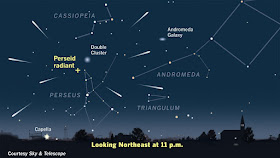The Perseid Meteor shower lasts from late July to early September each year, and are expected to be at a peak on 12-13 August 2015, which falling slightly before the new moon of 14 August, should mean could viewing from most parts of the globe. At the peak of the shower there can be 50-100 meteors per hour. The Perseids get their name from the constellation of Perseus, in which the meteors have their radiant (the point from which they appear to originate).
The radiant of the Perseid Meteors. Sky and Telescope.
The shower is caused by the Earth passing through the trail of the Comet 109P/Swift-Tuttle, and encountering dust from the tail of this comet. The dust particles strike the atmosphere at speeds of over 200 000 km per hour, burning up in the upper atmosphere and producing a light show in the process.
The Earth does not need to pass close to 109P/Swift-Tuttle for the meteor shower to occur, it simply passes through a trail of dust from the comet's tail that is following the same orbital path. Comet 109P/Swift-Tuttle itself only visits the Inner Solar System once every 133 years, last doing so in 1992. It is currently 36.4 AU from the Earth (i.e. 36.4 times as far from the Earth as the Sun, more than twice the distance between Neptune and the Sun) on an eccentric orbit tilted at 113° to the plane of the Solar System (or 67° with a retrograde orbit - an orbit in the opposite direction to the planets - depending on how you look at it), that takes it from 0.95 AU from the Sun (95% of the distance at which the Earth orbits the Sun) to 51.22 AU from the Sun (51.22 times as far from the Sun as the Earth, more than three times as far from the Sun as Neptune and slightly outside the Kuiper Belt, but only scraping the innermost zone of the Oort Cloud).
The orbit of 109P/Swift-Tuttle. Note that this is almost entirely below the plain of the Solar System. JPL Small Body Database Browser.
109P/Swift-Tuttle is next expected to visit the Inner Solar System in 2126, reaching about 22 950 00 km (0.15 AU) from Earth in August of that year.
See also...
Comet C/2014 Q1 (PANSTARRS) reached its perihelion (the closest point on its orbit to the Sun) on Monday 6 July 2015, when it was 0.31 AU from the Sun (i.e. 0.31 times the average distance...
 2015's Eta Aquarid Meteors.
2015's Eta Aquarid Meteors.The Eta Aquarid Meteor Shower will be at a peak on Tuesday 5/Wednesday 6 May 2014, with up to 45 meteors per hour at its peak, radiating from the constellation of Aquarius...
 The effect of the Perseid Meteor Shower on the Lunar Exosphere.
The effect of the Perseid Meteor Shower on the Lunar Exosphere.The Moon lacks a dense atmosphere in which gases can interact to create weather systems or undergo chemical reactions, but it...
Follow Sciency Thoughts on Facebook.



